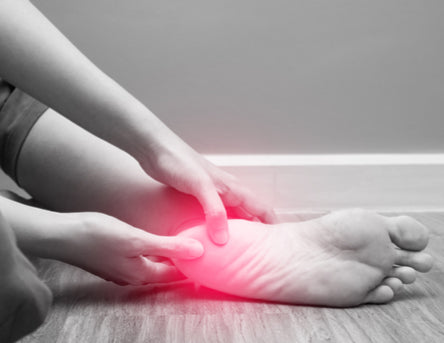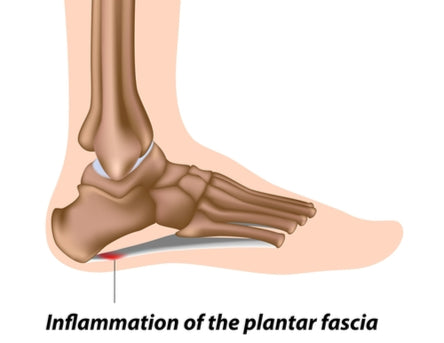Plantar Fasciitis (Heel Pain): Causes, Symptoms, and Treatment
Recommended for Plantar Fasciitis (Heel Pain): Causes, Symptoms, and Treatment
View allFeeling a sharp, stabbing pain in the bottom of your foot near your heel? It could be plantar fasciitis.
Plantar Fasciitis is the most common cause of heel pain. Your plantar fascia is a thick band of tissue that supports the arch of your foot and connects your heel bone to your toes. If you strain this tissue, it can become swollen and inflamed, thus causing pain in your heel and throughout your entire arch when you stand or walk.
Read on to learn more about the causes of plantar fasciitis, the symptoms of it, and how it can be treated.

Plantar Fasciitis is the most common cause of heel pain. If you treat the symptoms of plantar fasciitis in their early stages then the condition is much easier to manage.
Browse our full collection of insoles for plantar fasciitis.
What Is Plantar Fasciitis?
Plantar fasciitis can be an extremely painful condition in the foot – that’s because every step you take puts stress on the plantar fascia tissue.
As you walk or stand the plantar fascia can become inflamed, which contributes to increased discomfort and pain that only worsens over time. The pain associated with plantar fasciitis usually begins in the heel, and as the condition becomes severe, it can spread through the entire arch of the foot. Plantar Fasciitis should be treated as early as possible at the onset because the longer it persists without proper treatment, the longer it can take to heal.
What Does Plantar Fasciitis Pain Feel Like?
Plantar fasciitis pain is often described as a sharp, stabbing, or burning sensation at the bottom of the heel. Some individuals liken it to the sensation of walking on a small pebble or stepping on a nail.
When is Plantar Fasciitis Pain the Worst?
You might feel the pain thPlantar fasciitis pain can come on suddenly, but you might feel the pain the most in your first few steps after waking up in the morning or after a long period of rest.
This is because, throughout a night of rest, the plantar fascia contracts and micro-healing occurs. The abrupt stretching of the tissue during those first morning steps causes immediate pain and increased inflammation of the plantar fascia. The pain usually decreases after some movement, but often returns after long periods of standing or when you rise from a long period of sitting.
Other triggers include:
- Being on your feet for long durations, especially on hard surfaces.
- Shoes lacking good arch support or cushioning.
- Especially high-impact exercises such as running or jumping.
- Prolonged walking, especially without periodic breaks.
- Wearing high heels. They can strain the arch and heel, causing a flare-up.What Triggers Plantar Fasciitis Pain?

As you walk the plantar fascia can become inflamed, which contributes to increased discomfort and pain that only worsens over time.
What Causes Plantar Fasciitis?
There are numerous causes of plantar fasciitis that are worth reviewing. The most common are:
- A strain of the plantar fascia
- Improper shoe support
Strain of Plantar Fascia
Strain and inflammation of the plantar fascia are the primary causes of the heel and arch pain felt with plantar fasciitis. Those who overpronate and roll their feet inward as they walk are more susceptible to developing the condition, but it can show up in all foot types, including high arches and flat feet.
Improper Shoe Support
Often, plantar fasciitis is caused by wearing shoes that do not have proper support. Soft, cushy shoes that bend easily generally aggravate the condition, as do flat shoes with no support.
Other contributing factors can include:
- Poor foot Mechanics: Issues like flat feet, high arches, or abnormal gait (like overpronation) can stress the plantar fascia.
- Excessive Weight: Being overweight or obese increases strain on the plantar fascia due to increased pressure on the feet.
- Standing for long periods of time: Jobs that require prolonged standing or walking on hard surfaces can contribute to its onset.
- Repetitive Impact Activities: High-impact sports like running, basketball, or dance can increase the risk.
- Tight Achilles Tendons or Calf Muscles: This tightness can limit ankle motion, putting strain on the plantar fascia.

Many cases of this painful condition have been found in those who stand or work on cement surfaces all day long.
What Can I Do to Treat Plantar Fasciitis?
Basic home treatment is often effective for plantar fasciitis, the most important factor being supportive shoes. Insoles and orthotics can also be very helpful in relieving the pain of this condition. Some of the best arch supports have deep heel cups, which funnel the fat pad of the heel beneath the heel bone, causing it to act as a natural cushion.
Should you choose insoles to help relieve plantar fasciitis pain, we recommend the following products:
- Cadence Original (for low to medium arch or moderate overpronation)
- Form Maximum (for medium to high arch)
- 10 Seconds Ultra Arch (for high arch or moderate underpronation/supination)
- 10 Seconds Motion Control (for low to medium arch)
Often, people do not realize the difference that supportive shoes and insoles can make in the healing process and turn to more expensive medical options first. But many who focus on supportive footwear along with light stretching and ice experience complete relief from the symptoms over time.
Other treatment options include:
- Rest (RICE)
- Avoid walking barefoot
- Plantar Fasciitis Socks
- Night Brace
- Seeing a doctor
- Seeing a physical therapist
Rest And Avoid Activity
If you are suffering from plantar fasciitis, it is important to rest your feet and avoid activities that make your feet hurt. This will allow time for the plantar fascia to heal. Ice the painful area for 15 to 20 minutes once or twice daily, especially after activity. Over-the-counter pain medication may be needed to reduce swelling when the condition flares up. Gentle toe, calf, and arch stretches can be helpful, especially first thing in the morning before stepping your foot onto the floor. Lightly massaging the foot with a tennis ball a few times throughout the day can also help provide relief. If you need to exercise, you may want to try low-impact sports, such as swimming or riding a bike, instead of walking or jogging. As the condition improves, you can slowly work back into exercise and sports that have a higher impact. Not sure which stretches are the best? Check out our guide to the best stretches for plantar fasciitis.
Avoid Walking Barefoot
Once you develop plantar fasciitis, you should avoid walking barefoot, especially on hard surfaces such as wood floors or cement.
A supportive slipper or house shoe can be worn in the house and should be placed on the foot first thing in the morning before the foot comes into contact with the floor. The immediate relief will be felt. Supporting the arch of the foot first thing in the morning will allow the micro-healing that took place throughout the night to remain intact. Once your plantar fasciitis is gone, it is generally best to remain in the habit of avoiding walking around barefoot. Those who have developed plantar fasciitis once in their life are very susceptible to developing it again. It is wise to continue selecting supportive footwear and protecting the foot from conditions where plantar fasciitis could redevelop.
See A Doctor
If your plantar fasciitis pain is persistent after basic home treatment, you should make sure to see a doctor. There are more extensive procedures that can be helpful in relieving the pain, which can include cortisone shots or other procedures. Surgery is rarely needed for this condition and is usually only considered when all else fails, as it is not a desirable option.
See A Physical Therapist
A physical therapist may recommend certain exercises to strengthen your lower leg muscles and stretch the plantar fascia and Achilles tendon, thus stabilizing your ankle and heel. These can be very beneficial in helping to improve the condition. Your doctor or physical therapist may also recommend night splints to help with stretching your calf and the arch of your foot while you sleep.
What To Look For In Insoles For Plantar Fasciitis
If you decide to shop for insoles to help ease the pain of plantar fasciitis or help treat it, here are a few factors to consider when browsing:
- Arch Support: Ensures the foot's natural arch is supported, reducing strain.
- Deep Heel Cup: Look for insoles that stabilize the foot and offer cushioning directly under the heel.
- Material: We recommend you look for insoles that combine some cushion and firmness for comfort. Be careful that the product is not too soft and squishy as this can actually aggravate the plantar fascia.
- Thickness: Make sure to match the thickness to the available space in your shoes and your comfort preference.
- Shock Absorption: Opt for insoles with gel pads or cushioning in the heel region.
- Durability: Ensure the insoles are made of materials that can withstand regular wear; otherwise, they lose their supportive properties over time and effectiveness as a result.
Check out our collection of insoles for plantar fasciitis. We specifically curated these products with the above properties in mind.








